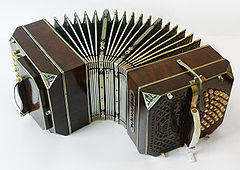Tango (music)
| Tango | |
|---|---|
| Stylistic origins | European styles including polka, habanera, flamenco, mazurka, and contradanse; Candombe, vals criollo, milonga. |
| Cultural origins | Argentina and Uruguay |
| Typical instruments | Violin, piano, guitar, flute, double bass and bandoneón |
| Subgenres | |
| Neotango – Tango-canción | |
| Fusion genres | |
| Tango-rock | |
| Regional scenes | |
| Dodompa (Japanese tango) – Easter Island | |
| Other topics | |
|
Dance – Maxixe (Brazilian tango) |
|
Dance – Maxixe (Brazilian tango)
Record labels
Tango is a style of music in 2/4 or 4/4 time that originated among European immigrant populations of Argentina and Uruguay (collectively, the "Rioplatenses"). It is traditionally played on a solo guitar, guitar duo, or an ensemble, known as the orquesta típica, which includes at least two violins, flute, piano, double bass, and at least two bandoneóns. Sometimes guitars and a clarinet join the ensemble. Tango may be purely instrumental or may include a vocalist. Tango music and dance have become popular throughout the world.
Even though present forms developed in Argentina and Uruguay from the mid 19th century, there are records of 19th and early 20th century Tango styles in Cuba and Spain, while there is a flamenco Tangos dance that may share a common ancestor in a minuet-style European dance. All sources stress the influence of the African communities and their rhythms, while the instruments and techniques brought in by European immigrants in the 20th century played a major role in its final definition, relating it to the Salon music styles to which Tango would contribute back at a later stage.
The first Tango ever recorded was made by Angel Villoldo and played by the French national guard in Paris. Villoldo had to record in Paris because in Argentina at the time there was no recording studio.
Early tango was played by immigrants in Buenos Aires and Montevideo. The first generation of tango players was called "Guardia Vieja" (the Old Guard). It took time to move into wider circles: in the early 20th century it was the favorite music of thugs and gangsters who visited the brothels, in a city with 100,000 more men than women (in 1914). The complex dances that arose from such rich music reflects how the men would practice the dance in groups, demonstrating male sexuality and causing a blending of emotion and aggressiveness. The music was played on portable instruments: flute, guitar and violin trios, with bandoneón arriving at the end of the 19th century. The organito, a portable player-organ, broadened the popularity of certain songs. Eduardo Arolas was the major instrument of the bandoneón's popularization, with Vicente Greco soon standardizing the tango sextet as consisting of piano, double bass, two violins and two bandoneóns.
...
Wikipedia

